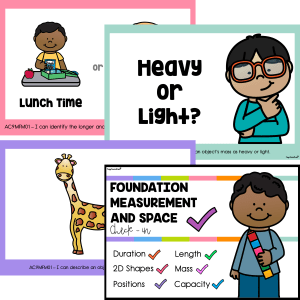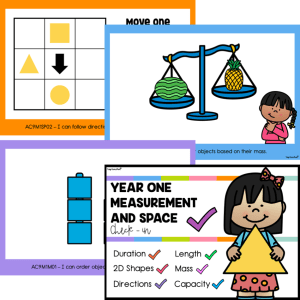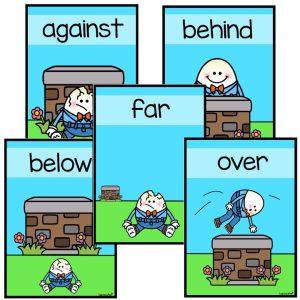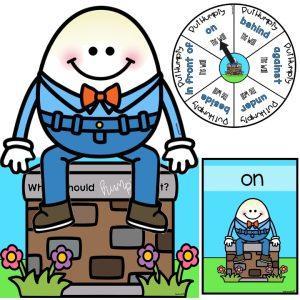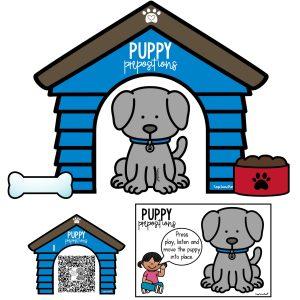Can You Find the Bumblebee? Positional Language Booklet

Description
Support your students in building spatial awareness and positional vocabulary with the engaging Can You Find the Bumblebee? Positional Language Booklet. This interactive, cut-and-paste resource allows students to explore key location terms by placing a bee and a flower into different positions on each page. With a consistent structure and hands-on format, this booklet helps reinforce prepositions through visual learning and creativity.
Each page focuses on a different positional word, providing a space for students to glue a bee and a flower according to the term shown. By working through the pages, students build their understanding of where objects are placed in relation to each other using words like on, under, above, behind, and more. With a bee and flower theme that is both simple and engaging, this activity is a great fit for young learners developing foundational language and direction skills.
The positional terms included in the booklet are: on, next to, in front, under, between, near, above, and behind. The repetitive structure allows for independent use, small group instruction, or whole-class modelling. It also provides valuable fine motor practice through cutting and gluing, while supporting literacy and mathematical language development. Students will enjoy assembling their own booklets, and the finished product serves as a visual reference they can return to during future tasks.
Key Learning Outcomes:
- ✅ Identify and understand key positional words
- ✅ Represent spatial relationships through hands-on tasks
- ✅ Strengthen vocabulary by connecting words with visual placement
- ✅ Follow multi-step instructions with increasing independence
- ✅ Develop fine motor skills through cutting and gluing
What’s Included:
- 8-page positional language booklet (one page per term)
- Bee and flower cut-out sheets to use on each page
- Cover page for personalisation
- Teacher instructions for classroom use and assembly
Materials Needed:
- Printed booklet pages and cut-outs
- Scissors and glue sticks
- Stapler or binder clips to assemble the finished book
- Optional: coloured pencils for decoration or outlining
How to Use:
- Print and distribute the booklet pages to students.
- Review each positional word with a class discussion or demonstration.
- Students cut out the bees and flowers and glue them in the correct locations on each page.
- Continue through each page until the entire booklet is complete.
- Bind the pages together for a reusable student-made reference book.
Ideas for Classroom Use:
- 💡 Include in a literacy or maths centre focused on position and direction
- 💡 Use during small group work or intervention sessions for EAL learners
- 💡 Pair with physical objects like toys or blocks for a hands-on introduction before starting the booklet
- 💡 Display completed booklets for students to revisit during writing or reading tasks
Top Teacher Tips:
- 💛 Pre-cut the shapes for younger students or those who need motor support
- 💛 Use real bees and flower props during lessons for extra visual support
- 💛 Create an anchor chart of the terms alongside the booklet for reference
- 💛 Pair students to talk through their choices and explain their placement using positional words
Can You Find the Bumblebee? Positional Language Booklet is a creative and structured way to teach prepositions, spatial relationships, and fine motor skills. It is a perfect addition to your early years program and supports confidence through clear, visual learning.
Additional information
| Australian Curriculum Code | AC9M1SP02, AC9M2SP02, AC9MFSP02 |
|---|---|
| File Format |
Australian Curriculum V9
F - 6
Lorem ipsum dolor sit amet, consectetur adipiscing elit.
Lorem ipsum dolor sit amet, consectetur adipiscing elit.
Lorem ipsum/ Lorem ipsum/ Lorem ipsum
Lorem ipsum dolor sit amet, consectetur adipiscing elit.
Lorem ipsum dolor sit amet, consectetur adipiscing elit.
Lorem ipsum/ Lorem ipsum/ Lorem ipsum
Lorem ipsum dolor sit amet, consectetur adipiscing elit.
Lorem ipsum dolor sit amet, consectetur adipiscing elit.
Lorem ipsum/ Lorem ipsum/ Lorem ipsum
Lorem ipsum dolor sit amet, consectetur adipiscing elit.
Lorem ipsum dolor sit amet, consectetur adipiscing elit.
Lorem ipsum/ Lorem ipsum/ Lorem ipsum
Lorem ipsum dolor sit amet, consectetur adipiscing elit.
Lorem ipsum dolor sit amet, consectetur adipiscing elit.
Lorem ipsum/ Lorem ipsum/ Lorem ipsum
